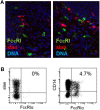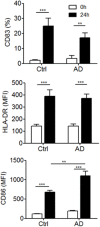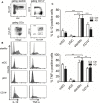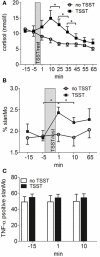Phenotype, Function, and Mobilization of 6-Sulfo LacNAc-Expressing Monocytes in Atopic Dermatitis
- PMID: 29977237
- PMCID: PMC6021776
- DOI: 10.3389/fimmu.2018.01352
Phenotype, Function, and Mobilization of 6-Sulfo LacNAc-Expressing Monocytes in Atopic Dermatitis
Abstract
Mononuclear phagocytes (MPs) are important immune regulatory cells in atopic dermatitis (AD). We previously identified 6-sulfo LacNAc-expressing monocytes (slanMo) as TNF-α- and IL-23-producing cells in psoriatic skin lesions and as inducers of IFN-γ-, IL-17-, and IL-22-producing T cells. These cytokines are also upregulated in AD and normalize with treatment, as recently shown for dupilumab-treated patients. We here asked for the role of slanMo in AD. Increased numbers of slanMo were found in AD skin lesions. In difference to other MPs in AD, slanMo lacked expression of FcɛRI, CD1a, CD14, and CD163. slanMo from blood of patients with AD expressed increased levels of CD86 and produced IL-12 and TNF-α at higher amounts than CD14+ monocytes and myeloid dendritic cells. While CD14+ monocytes from patients with AD revealed a reduced IL-12 production, we observed no difference in the cytokine production comparing slanMo in AD and healthy controls. Interestingly, experimentally induced mental stress, a common trigger of flares in patients with AD, rapidly mobilized slanMo which retained their high TNF-α-producing capacity. This study identifies slanMo as a distinct population of inflammatory cells in skin lesions and as proinflammatory blood cells in patients with AD. slanMo may, therefore, represent a potent future target for treatment of AD.
Keywords: 6-sulfo LacNAc-expressing monocytes; CD86; IL-12; atopic dermatitis; dendritic cells; immunology; inflammation.
Figures





Similar articles
-
Current Concepts on 6-sulfo LacNAc Expressing Monocytes (slanMo).Front Immunol. 2019 May 22;10:948. doi: 10.3389/fimmu.2019.00948. eCollection 2019. Front Immunol. 2019. PMID: 31191513 Free PMC article. Review.
-
Neoadjuvant Radiochemotherapy Significantly Alters the Phenotype of Plasmacytoid Dendritic Cells and 6-Sulfo LacNAc+ Monocytes in Rectal Cancer.Front Immunol. 2019 Mar 29;10:602. doi: 10.3389/fimmu.2019.00602. eCollection 2019. Front Immunol. 2019. PMID: 30984181 Free PMC article.
-
Human innate immune cell crosstalk induces melanoma cell senescence.Oncoimmunology. 2020 Aug 30;9(1):1808424. doi: 10.1080/2162402X.2020.1808424. Oncoimmunology. 2020. PMID: 32939325 Free PMC article.
-
6-Sulfo LacNAc monocytes are quantitatively and functionally disturbed in systemic sclerosis patients.Clin Exp Immunol. 2022 Aug 19;209(2):175-181. doi: 10.1093/cei/uxac059. Clin Exp Immunol. 2022. PMID: 35758259 Free PMC article.
-
The adaptive immune system in atopic dermatitis and implications on therapy.Expert Rev Clin Immunol. 2016 Jul;12(7):787-96. doi: 10.1586/1744666X.2016.1165093. Epub 2016 Mar 28. Expert Rev Clin Immunol. 2016. PMID: 26967382 Review.
Cited by
-
Inhibition of Dendritic Cell Activation and Modulation of T Cell Polarization by the Platelet Secretome.Front Immunol. 2021 Feb 25;12:631285. doi: 10.3389/fimmu.2021.631285. eCollection 2021. Front Immunol. 2021. PMID: 33737933 Free PMC article.
-
Immune complex-induced haptokinesis in human non-classical monocytes.Front Immunol. 2023 Mar 1;14:1078241. doi: 10.3389/fimmu.2023.1078241. eCollection 2023. Front Immunol. 2023. PMID: 36936904 Free PMC article.
-
Current Concepts on 6-sulfo LacNAc Expressing Monocytes (slanMo).Front Immunol. 2019 May 22;10:948. doi: 10.3389/fimmu.2019.00948. eCollection 2019. Front Immunol. 2019. PMID: 31191513 Free PMC article. Review.
-
Costimulatory Molecules and Immune Checkpoints Are Differentially Expressed on Different Subsets of Dendritic Cells.Front Immunol. 2019 Jun 11;10:1325. doi: 10.3389/fimmu.2019.01325. eCollection 2019. Front Immunol. 2019. PMID: 31244860 Free PMC article.
-
Dendritic Cells and Macrophages in the Pathogenesis of Psoriasis.Front Immunol. 2022 Jun 28;13:941071. doi: 10.3389/fimmu.2022.941071. eCollection 2022. Front Immunol. 2022. PMID: 35837394 Free PMC article. Review.
References
LinkOut - more resources
Full Text Sources
Other Literature Sources
Research Materials

